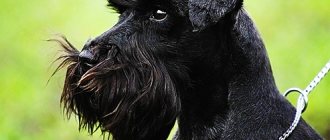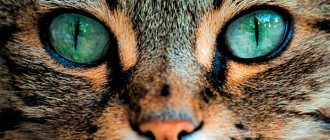How does a dog's eye work?
The visual organs of dogs and humans are similar. The eye consists of an apple and eyelids, of which there are three - upper, lower and a thin membrane. The latter periodically closes her eye. The purpose of the membrane is to protect the eye from dust and foreign particles. The eyeball has the following structure:
- The first layer is the transparent cornea, which protects the lens and conducts light signals.
- The second layer is the iris of the eye, consisting of a network of capillaries. In the center of the iris is the pupil, and behind it is the lens. The lens moves thanks to muscle fibers. Depending on the distance at which the object is located, the lens changes its curvature. Behind it is the vitreous body.
- The retina is the third layer. It is equipped with many nerve endings that communicate with the brain. The function of the retina is to encode impulses coming from outside and convert them into signals, which are then sent to the cerebral cortex.
The eye is equipped with a tear duct. Periodically produced tears moisten the apple and cleanse the organ of impurities.
Additional Information. The dog's eye lacks a “yellow spot”, the function of which is to maintain visual acuity.
Therefore, animals see all objects somewhat blurry, without clear lines and boundaries.
Features of vision
The fact that dogs see the world in black and white is not supported by scientific research. However, vision in animals has a number of its own specific characteristics:
- The severity is reduced, which is explained by behavioral characteristics. The animal must see equally well both in the dark and during the day. All dogs are endowed with slight farsightedness. If a static object is located at a distance of 50 m or further, the pet will see it blurry.
- Color perception in dogs is poorer than in humans, this is due to a smaller set of cones.
- Photosensitivity. A dog sees several times better at night than its owner. This is due to the fact that animals have more rods – special cells – in their eyes. In addition, animals by nature are more sensitive to light.
- Overview – it varies depending on the breed. Unlike humans, in pets the axis of each eye is not parallel. The dog's field of vision depends on the shape of the skull and the placement of the eyes. The greater the angle at which the eyes diverge, the better the animal’s vision. Breeds whose eyes are located at a distance from each other have a wide field of vision, while small ornamental ones (Chihuahuas, pugs) have a narrow field of vision.
- Movement – dogs can more easily distinguish moving objects. This is due to the characteristics of the retina, which has a large number of light-sensitive rods. Static objects will be less distinguishable, and the dog may simply not notice them. An animal can ignore an object lying nearby, but can immediately see a running cat or a flying bird.
- Image frequency – a dog's eye perceives an image at a frequency of 80 Hz, while the human eye perceives an image at a frequency of 60 Hz. Therefore, pets cannot watch TV.
Decorative breeds do not have the same range of vision as their hunting cousins
. Additional information. Because dogs cannot distinguish between the red spectrum, they do not perceive yellow and green shades. Instead they see white and black.
During the day
During the daytime, a dog sees almost the same as people. Its retina is divided into 2 halves, thanks to which it allows the pet to see well in different light conditions. In the lower part of the retina there is a dark pigment. It absorbs light rays. Due to this, in bright light or during the day, the lower part of the retina is activated.
At night time
During darkness, both halves of the retina are activated, which gives the dog an advantage over humans. In the darkness she will see 3-4 times better than people.
How does a dog see?
A dog sees the world differently than a human. While humans can clearly see different objects, dogs cannot. She doesn't see clear outlines. This can be compared to a person's very poor vision. But not everything is as bad as it might seem. For humans, vision plays a huge role, because people perceive 90% of information through vision. For a dog, eyes are only 30% of the information. Smell and hearing play a big role for her. Vision is only needed to understand where and what is, to serve the owner (bring slippers, work as a guide, and so on), and catch the ball. That is, it is like an auxiliary organ.
Due to the fact that there are more rods in the retina of a dog’s eye, it is better able to distinguish a moving object, rather than one that stands still. For example, a dog will see a running hare at a distance of 900 meters, but a doe standing still only from 600 meters. This feature is directly related to the origin of the animal. This is, first of all, a hunter, and not a pet. Since ancient times, they have been getting their own food. To be able to catch the “dinner”, a predator needs to be able to look at it and catch up with it, without losing sight of it during the chase.
A couple more features are associated with the structure of the dog’s skull. A dog's field of vision is elongated, while a person's is round. And their angle of vision reaches 250 degrees, while humans have only 180 degrees. But the latter indicator cannot be called static. The angle of view largely depends on the breed, or more precisely on the muzzle. For example, a pug, which has a wide head, will have a smaller angle than hunting breeds, which have a narrow, slightly oblong skull.
Can dogs distinguish colors, what colors do they see?
Not every color can be perceived by dogs the same as humans. You can understand what colors dogs distinguish by looking at how they see the spectrum compared to humans:
- purple – a dark shade of blue;
- blue – blue;
- blue - gray;
- green – pale yellow;
- orange – light brown;
- red – deep gray.
By understanding how dogs see colors, it becomes clear why most pet toys, particularly balls, are colored red. When the ball hits the lawn, the two colors merge into one, gray, for the pet, and he is not able to find the toy. What saves in this case is the animal’s sense of smell.
Do dogs have worse eyesight than humans?
It is impossible to answer unequivocally the question of whether dogs see worse than people. The main differences between the vision of dogs and humans:
- Accurate distance determination. Where the macula is located in humans, animals have a lot of rods. This is the area where light rays are not distorted. Thanks to this, the animal clearly determines the direction of the object.
- In humans, the field of vision is circular, in animals it is extended. Because of this feature, the viewing angle is up to 250 degrees, which is 60 degrees more than that of humans.
An example of how colors are perceived by people and their pets
. Additional information. Another difference and advantage of an animal’s vision is the ability to clearly see a moving object at a distance of up to 900 m. Thanks to this feature, dogs have excellent hunting qualities.
They will see the same object, but static, from a distance of 600 m.
Color vision and myopia
Only deepening into biology allows us to understand exactly how a dog perceives the world around it. Photoreceptors are responsible for the perception of colors in the structure of the eye: these are rods and cones on the retina, which received such names due to their shape. There are three types of cones on the retina of the human eye, and they allow us to distinguish shades of red, green and blue.
A dog's eye is structured differently: for example, it has only two types of cones on its retina, and for this reason, pets are not able to see the difference between yellow-green and red-orange shades.
The picture of the world that dogs see is similar to the way colorblind people see the world.
For example, a pet is unlikely to see a red ball or toy in the grass. But here the sense of smell comes to the rescue: the dog can smell them.
However, this is not the only difference between human and dog vision. As it turned out, these animals see the picture of the world much less clearly than humans. The reason also lies in the structure of the organs of vision. The yellow spot is responsible for the clarity and brightness of the image that a person sees. The dog does not have this spot, so pets have difficulty distinguishing details. If a person with good eyesight is able to read the tenth line of the vision test table, then theoretically a dog can only recognize the third. But for animals, visual acuity is not as important as the ability to recognize a potential victim in time.
What is more important for a dog – vision or smell?
People learn 90% of information through vision. For the younger brothers, everything is different. Since they cannot see close objects, especially if they are in a static position, their sense of smell saves them. This way they recognize plants, their toys and other objects. Therefore, an animal’s sense of smell is paramount for obtaining information about the surrounding world.
Note! If you play with your pet with two balls of yellow and red, he will not be able to distinguish them, because they will look identical to him in shade. And only thanks to the sense of smell the animal will be able to understand which ball is which.
Why is it so important for dog owners to know about their pets’ visual needs?
Every dog owner should know that their pet can only see specific colors. First of all, this is necessary to select the right toys for him. They should be blue or yellow, he can distinguish between them. The correct color choice of equipment will greatly facilitate and speed up the learning and training process.
Knowledge about the visual characteristics of pets will help the owner to properly concentrate their attention on himself. To do this, you need to stand directly in front of the animal, blocking its viewing angle as much as possible.
Thanks to the unique structure of their eyes, dogs have excellent vision in the dark.
Features of dog vision
But it is not all that bad. In some ways, a dog's eyes are superior to ours. Yes, not all colors are perceived by them, and their vision is not so sharp, but these disadvantages are compensated by the fact that their eyes are located on the sides of their heads. This makes the angle of peripheral vision much wider, thereby counterbalancing the lack of visual acuity.
The rod cells located in the dog's eyes make it possible to absorb the maximum amount of light. And the reflective cells under the retina make them shiny and allow you to see perfectly at dusk and dawn. Their eyes seem to glow in the dark. But they simply reflect the light falling on them, like spotlights. And one more advantage: the dog's eye has a larger number of cells in the retina, which are responsible for identifying the movement of objects in space, even over long distances. That's why they often bark with their heads up. It seems to us, often without reason. They are attracted to birds flying at high altitudes, but we may simply not see them.
Interesting Facts
How many colors a dog perceives is a well-known fact. The animal's vision is unique, and there is a lot of interesting information about it:
- How do guide dogs guide blind people across the road if they can't identify the colors at a traffic light? They don't even look at him. A service animal only follows the flow of traffic on the road.
- Reflective membranes located at the back of your pet's eye function like a mirror, providing additional illumination at night, so dogs can see better than people in the dark.
- Animals cannot watch TV. If the owner sees that his pet does not take his eyes off the screen, this does not mean that he is interested in the film. He is attracted by the flashing light.
- If your pet has problems with orientation in space, he begins to bump into objects, bangs against the doorframe - this is a sign that he has problems with his vision, and he needs to be shown to a veterinarian.
- Because dogs have difficulty seeing close objects, their eyes are susceptible to injury. It is important to always monitor the condition of your pet’s eyes, and if you notice signs such as itching, abnormal discharge, or swelling, contact your veterinarian immediately.
A dog's organs of vision are complex optical devices. Although animals do not see the full range of colors, their world is not confined to a boring black and white movie. It cannot be said that the younger brothers see people worse, they just perceive the surrounding reality somewhat differently, which has both its advantages and disadvantages.
https://youtu.be/1VJbhtO8-Bk











